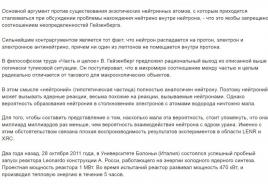Average acceleration. Acceleration
Acceleration Is a quantity that characterizes the rate of change in speed.
For example, a car, moving away from a place, increases its speed, that is, moves at an accelerated rate. Initially, its speed is zero. Having started from a place, the car gradually accelerates to a certain speed. If a red traffic light comes on on its way, the car will stop. But it will not stop immediately, but for some time. That is, its speed will decrease down to zero - the car will move slowly until it stops at all. However, there is no term "deceleration" in physics. If the body moves, slowing down the speed, then this will also be the body's acceleration, only with a minus sign (as you remember, speed is a vector quantity).
\u003e Is the ratio of the change in speed to the time interval for which this change occurred. You can determine the average acceleration by the formula:
 Fig. 1.8. Average acceleration.In SI unit of acceleration Is 1 meter per second per second (or meter per second squared), that is
Fig. 1.8. Average acceleration.In SI unit of acceleration Is 1 meter per second per second (or meter per second squared), that is
A meter per second squared is equal to the acceleration of a straight-line moving point, at which in one second the speed of this point increases by 1 m / s. In other words, acceleration determines how much the body's speed changes in one second. For example, if the acceleration is 5 m / s 2, then this means that the speed of the body increases by 5 m / s every second.
Instant acceleration of a body (material point) at a given moment in time is a physical quantity equal to the limit to which the average acceleration tends when the time interval tends to zero. In other words, this is the acceleration that the body develops in a very short period of time:
With accelerated rectilinear motion, the speed of the body increases in absolute value, that is
V 2\u003e v 1
and the direction of the acceleration vector coincides with the velocity vector
If the speed of the body decreases in absolute value, that is
V 2< v 1
then the direction of the acceleration vector is opposite to the direction of the velocity vector In other words, in this case, slowing down, and the acceleration will be negative (and< 0). На рис. 1.9 показано направление векторов ускорения при прямолинейном движении тела для случая ускорения и замедления.

Fig. 1.9. Instant acceleration.
When moving along a curved trajectory, not only the speed module changes, but also its direction. In this case, the acceleration vector is represented as two components (see next section).
Tangential (tangential) acceleration Is the component of the acceleration vector directed along the tangent to the trajectory at a given point of the trajectory of motion. Tangential acceleration characterizes the change in speed modulo during curvilinear motion.

Fig. 1.10. Tangential acceleration.
The direction of the tangential acceleration vector (see Fig. 1.10) coincides with the direction of the linear velocity or opposite to it. That is, the vector of tangential acceleration lies on the same axis with the tangent circle, which is the trajectory of the body.
Normal acceleration
Normal acceleration Is the component of the acceleration vector directed along the normal to the trajectory of motion at a given point on the trajectory of the body. That is, the vector of normal acceleration is perpendicular to the linear speed of movement (see Fig. 1.10). Normal acceleration characterizes the change in speed in the direction and is denoted by the letter The normal acceleration vector is directed along the radius of curvature of the trajectory.
Full acceleration
Full acceleration in curvilinear motion, it is composed of tangential and normal accelerations along and is determined by the formula:

(according to the Pythagorean theorem for a rectangular rectangle).
3.1. Equally alternating motion in a straight line.
3.1.1. Equally alternating motion in a straight line - movement in a straight line with constant magnitude and direction acceleration:
3.1.2. Acceleration () is a physical vector quantity that shows how much the speed will change in 1 s.
In vector form:
where is the initial speed of the body, is the speed of the body at the moment of time t.
Projected onto the axis Ox:
where is the projection of the initial velocity onto the axis Ox, is the projection of the body's velocity onto the axis Ox at the moment t.
The signs of the projections depend on the direction of the vectors and the axis Ox.
3.1.3. Acceleration versus time projection graph.
With an equally variable motion, the acceleration is constant, therefore it will be straight lines parallel to the time axis (see Fig.):
3.1.4. Speed \u200b\u200bwith equal motion.
In vector form:
Projected onto the axis Ox:
For uniformly accelerated motion:
For an even slow motion:
3.1.5. A graph of the projection speed versus time.
The graph of the projection of speed over time is a straight line.
Direction of movement: if the graph (or part of it) is above the time axis, then the body moves in the positive direction of the axis Ox.
Acceleration value: the greater the slope angle (the steeper it rises up or down), the greater the acceleration modulus; where is the change in speed over time
Intersection with the time axis: if the graph crosses the time axis, then the body slowed down to the point of intersection (uniformly slow motion), and after the intersection point it began to accelerate in the opposite direction (uniformly accelerated motion).
3.1.6. The geometric meaning of the area under the graph in axes
Area under the graph when on axis Oy the speed is plotted, and on the axis Ox - time is the path traversed by the body.
In fig. 3.5 the case of uniformly accelerated motion is shown. The path in this case will be equal to the area of \u200b\u200bthe trapezoid: (3.9)
3.1.7. Path formulas
| Equally accelerated movement | Equal slow motion |
|---|---|
| (3.10) | (3.12) |
| (3.11) | (3.13) |
| (3.14) | |
All formulas presented in the table work only if the direction of movement is preserved, that is, before the intersection of the straight line with the time axis on the graph of the velocity projection versus time.
If the intersection occurs, then the movement is easier to break into two stages:
before crossing (braking):
After crossing (acceleration, movement in the opposite direction)
In the formulas above - the time from the beginning of the movement to the intersection with the time axis (time to stop), - the path that the body has traveled from the beginning of the movement to the intersection with the time axis, - the time elapsed from the moment of crossing the time axis until the given moment t, is the path that the body has traveled in the opposite direction during the time elapsed from the moment of crossing the time axis to this moment t, is the module of the displacement vector for the entire time of movement, L - the path traversed by the body during the entire movement.
3.1.8. Move in a second.
During the time the body will pass the way:
During the time the body will pass the way:
Then in the th interval the body will pass the way:
Any period of time can be taken as a period. Most often with.
Then, in 1 second, the body travels the path:
In the 2nd second:
In the 3rd second:
If we look closely, we will see that, etc.
Thus, we come to the formula:
In words: the paths traversed by the body in successive intervals of time are related to each other as a series of odd numbers, and this does not depend on the acceleration with which the body moves. We emphasize that this relation is valid for
3.1.9. The equation of the coordinates of the body with equal motion
Coordinate equation
The signs of the projections of the initial velocity and acceleration depend on the relative position of the corresponding vectors and the axis Ox.
To solve problems, it is necessary to add the equation for changing the projection of the speed on the axis to the equation:
3.2. Graphs of kinematic values \u200b\u200bfor straight motion
3.3. Body free fall
Free fall means the following physical model:
1) Fall occurs due to gravity:
2) There is no air resistance (sometimes they write “neglect air resistance” in problems);
3) All bodies, regardless of mass, fall with the same acceleration (sometimes they add - "regardless of the shape of the body", but we consider the movement of only a material point, therefore the shape of the body is no longer taken into account);
4) Acceleration of free fall is directed strictly downward and is equal on the surface of the Earth (in problems we often take it for the convenience of calculations);
3.3.1. Equations of motion projected onto the axis Oy
Unlike movement along a horizontal straight line, when not all tasks change the direction of movement, in free fall it is best to immediately use the equations written in projections onto the axis Oy.
Body coordinate equation:
Velocity projection equation:
As a rule, in tasks it is convenient to select the axis Oy in the following way:
Axis Oy directed vertically upward;
The origin coincides with the ground level or the lowest point of the trajectory.
With this choice, the equations and will be rewritten as follows:
3.4. Plane movement Oxy.
We considered the motion of a body with acceleration along a straight line. However, the equally variable motion is not limited to this. For example, a body thrown at an angle to the horizon. In such tasks, it is necessary to take into account the movement along two axes at once:
Or in vector form:
And changing the speed projection on both axes:
3.5. Application of the concept of derivative and integral
We will not give here a detailed definition of the derivative and integral. To solve problems, we only need a small set of formulas.
Derivative:
where A, B and that is, constant values.
Integral:
Now let's see how the concept of a derivative and an integral is applied to physical quantities. In mathematics, the derivative is denoted "" ", in physics the time derivative is denoted by" ∙ "over the function.
Speed:
that is, the speed is a derivative of the radius vector.
For speed projection:
Acceleration:
that is, acceleration is a derivative of speed.
For acceleration projection:
Thus, if the law of motion is known, then we can easily find both the speed and acceleration of the body.
Now let's use the concept of an integral.
Speed:
that is, the speed can be found as the time integral of the acceleration.
Radius vector:
that is, the radius vector can be found by taking the integral of the velocity function.
Thus, if the function is known, then we can easily find both the speed and the law of motion of the body.
The constants in the formulas are determined from the initial conditions - the values \u200b\u200band at the time
3.6. Velocity triangle and displacement triangle
3.6.1. Speed \u200b\u200btriangle
In vector form at constant acceleration, the law of speed change has the form (3.5):
This formula means that the vector is equal to the vector sum of the vectors and the Vector sum can always be shown in the figure (see Fig.).
In each task, depending on the conditions, the velocity triangle will have its own form. This representation allows the use of geometric considerations in the solution, which often simplifies the solution of the problem.
3.6.2. Displacement triangle
In vector form, the law of motion at constant acceleration is:
When solving the problem, you can choose a frame of reference in the most convenient way, therefore, without losing generality, we can choose a frame of reference so that that is, the origin of the coordinate system is placed at the point where at the initial moment the body is located. Then
that is, the vector is equal to the vector sum of the vectors and will be shown in the figure (see figure).
As in the previous case, depending on the conditions, the displacement triangle will have its own form. This representation allows the use of geometric considerations in the solution, which often simplifies the solution of the problem.
Definition
Body acceleration is called a vector value showing the rate of change in the speed of movement of the body. Designate acceleration as $ \\ overline (a) $.
Average body acceleration
Let us assume that at times $ t $ and $ t + \\ Delta t $ the velocities are equal to $ \\ overline (v) (t) $ and $ \\ overline (v) (t + \\ Delta t) $. It turns out that during the time $ \\ Delta t $ the speed changes by the value:
\\ [\\ Delta \\ overline (v) \u003d \\ overline (v) \\ left (t + \\ Delta t \\ right) - \\ overline (v) \\ left (t \\ right) \\ left (1 \\ right), \\]
then the average acceleration of the body is:
\\ [\\ left \\ langle \\ overline (a) \\ right \\ rangle \\ left (t, \\ t + \\ Delta t \\ right) \u003d \\ frac (\\ Delta \\ overline (v)) (\\ Delta t) \\ left (2 \\ Instant body acceleration
Let us tend the time interval $ \\ Delta t $ to zero, then from equation (2) we obtain:
\\ [\\ overline (a) \u003d (\\ mathop (\\ lim) _ (\\ Delta t \\ to 0) \\ frac (\\ Delta \\ overline (v)) (\\ Delta t) \u003d \\ frac (d \\ overline (v) ) (dt) \\ left (3 \\ right). \\) \\]
Formula (3) is the definition of instantaneous acceleration. Whereas, in a Cartesian coordinate system:
\\ [\\ overline (r) \u003d x \\ left (t \\ right) \\ overline (i) + y \\ left (t \\ right) \\ overline (j) + z \\ left (t \\ right) \\ overline (k) \\ we get:
\\ [\\ overline (a) \u003d \\ overline (i) \\ frac (d ^ 2x) (dt ^ 2) + \\ overline (j) \\ frac (d ^ 2y) (dt ^ 2) + \\ overline (k) \\ From expression (6) it follows that the projections of the acceleration on the coordinate axes (X, Y, Z) are:
{!LANG-1e3436bc36f3ff70bb00137d9bf6e0a7!}
{!LANG-4c2ec0659e6eb7792d00fd40575eb56b!}
{!LANG-601fcc5656bb8143e6507a2be9c77b84!}
\\ [\\ left \\ (\\ begin (array) (c) a_x \u003d \\ frac (d ^ 2x) (dt ^ 2), \\\\ a_y \u003d \\ frac (d ^ 2y) (dt ^ 2) \\\\ a_z \u003d \\ In this case, the acceleration module is found in accordance with the expression:
To clarify the question of the direction of acceleration of the body's motion, we represent the velocity vector as:
\\ [\\ overline (v) \u003d v \\ overline (\\ tau) \\ left (8 \\ right), \\]
where $ v $ is the body's velocity module; $ \\ overline (\\ tau) $ - unit vector tangent to the trajectory of the material point. Substituting expression (8) into the definition of instantaneous speed, we get:
\\ [\\ overline (a) \u003d (\\ frac (d \\ overline (v)) (dt) \u003d \\ frac (d) (dt) \\ left (v \\ overline (\\ tau) \\ right) \u003d \\ overline (\\ tau ) \\ frac (dv) (dt) + v \\ frac (d \\ overline (\\ tau)) (dt) \\ left (9 \\ right). \\) \\]
The unit tangent vector $ \\ overline (\\ tau) $ is defined by the point of the trajectory, which in turn is characterized by the distance ($ s $) from the starting point. So the vector $ \\ overline (\\ tau) $ is a function of $ s $:
\\ [\\ overline (\\ tau) \u003d \\ overline (\\ tau) \\ left (s \\ right) \\ left (10 \\ right). \\]
The $ s $ parameter is a function of time. We get:
\\ [\\ frac (d \\ overline (\\ tau)) (dt) \u003d \\ frac (d \\ overline (\\ tau)) (ds) \\ frac (ds) (dt) \\ left (11 \\ right), \\]
where the vector $ \\ overline (\\ tau) $ does not change modulo. This means that the vector $ \\ frac (d \\ overline (\\ tau)) (ds) $ is perpendicular to $ \\ overline (\\ tau) $. The vector $ \\ overline (\\ tau) (\\ rm \\) $ is tangent to the trajectory, $ \\ frac (d \\ overline (\\ tau)) (ds) $ is perpendicular to this tangent, that is, directed along the normal, which is called the main ... The unit vector in the direction of the principal normal will be denoted by $ \\ overline (n) $.
the value $ \\ left | \\ frac (d \\ overline (\\ tau)) (ds) \\ right | \u003d \\ frac (1) (R) $, where $ R $ is the radius of curvature of the trajectory.
And so we got:
\\ [\\ frac (d \\ overline (\\ tau)) (ds) \u003d \\ frac (\\ overline (n)) (R) \\ left (12 \\ right). \\]
Taking into account that $ \\ frac (ds) (dt) \u003d v $, from (9) we can write the following:
\\ [\\ overline (a) \u003d \\ overline (\\ tau) \\ frac (dv) (dt) + v \\ frac (\\ overline (n)) (R) v \u003d \\ overline (\\ tau) \\ frac (dv) ( dt) + \\ frac (v ^ 2) (R) \\ overline (n) \\ left (13 \\ right). \\]
Expression (13) shows that the total acceleration of the body consists of two components, which are mutually perpendicular. Tangential acceleration ($ (\\ overline (a)) _ (\\ tau) $), directed tangentially to the trajectory of motion and equal to:
\\ [(\\ overline (a)) _ (\\ tau) \u003d \\ overline (\\ tau) \\ frac (dv) (dt) (14) \\]
and normal (centripetal) acceleration ($ (\\ overline (a)) _ n $) directed perpendicular to the tangent to the trajectory at the point of the body along the main normal (to the center of curvature of the trajectory) and equal to:
{!LANG-ea3d205a1b0f61959d8d51e9adf21985!}
\\ [(\\ overline (a)) _ n \u003d \\ frac (v ^ 2) (R) \\ overline (n) \\ left (15 \\ right). \\]
Full acceleration modulus is:
The SI unit of acceleration is meter per second squared:
\\ [\\ left \u003d \\ frac (m) (s ^ 2). \\]
Rectilinear body movement
If the trajectory of the material point is a straight line, then the acceleration vector is directed along the same straight line as the velocity vector. Only the speed value changes.
Variable motion is called accelerated if the speed of a material point is constantly increasing in absolute value. In this case, $ a\u003e 0 $, the acceleration and velocity vectors are co-directed.
If the speed modulo decreases, then the motion is called decelerated ($ a
The movement of a material point is called equally variable and rectilinear if the movement occurs with constant acceleration ($ \\ overline (a) \u003d const $). With an equally variable motion, the instantaneous velocity ($ \\ overline (v) $) and the acceleration of a material point are related by the expression:
\\ [\\ overline (v) \u003d (\\ overline (v)) _ 0+ \\ overline (a) t \\ \\ left (3 \\ right), \\]
where $ (\\ overline (v)) _ 0 $ is the speed of the body at the initial moment of time.
Examples of tasks with a solution
Example 1
The task: The motions of two material points are given by the following kinematic equations: $ x_1 \u003d A + Bt-Ct ^ 2 $ and $ x_2 \u003d D + Et + Ft ^ 2, $ to which the accelerations of these two points are equal at the time when their velocities are equal if $ A $, B, C, D, EF are large zero constants.
Decision: Let's find the acceleration of the first material point:
\\ [(a_1 \u003d a) _ (x1) \u003d \\ frac (d ^ 2x_1) (dt ^ 2) \u003d \\ frac (d ^ 2) (dt ^ 2) \\ left (A + Bt-Ct ^ 2 \\ right) \u003d -2C \\ (\\ frac (m) (c ^ 2)). \\]
At the second material point, the acceleration will be equal to:
\\ [(a_2 \u003d a) _ (x2) \u003d \\ frac (d ^ 2x_2) (dt ^ 2) \u003d \\ frac (d ^ 2) (dt ^ 2) \\ left (D + Et + Ft ^ 2 \\ right) \u003d 2F \\ left (\\ frac (m) (c ^ 2) \\ right). \\]
We got that the points move with constant accelerations that do not depend on time, therefore, it is not necessary to search for the moment at which the speeds are equal.
Answer: $ a_1 \u003d -2C \\ frac (m) (c ^ 2) $, $ a_2 \u003d 2F \\ frac (m) (c ^ 2) $
Example 2
The task: The movement of a material point is given by the equation: $ \\ overline (r) \\ left (t \\ right) \u003d A \\ left (\\ overline (i) (\\ cos \\ left (\\ omega t \\ right) + \\ overline (j) (\\ sin \\ left (\\ omega t \\ right) \\) \\) \\ right), $ where $ A $ and $ \\ omega $ are constants. Draw the trajectory of the point, draw on it the acceleration vector of this point. What is the centripetal acceleration modulus ($ a_n $) of the point in this case?
Decision: Consider the equation of motion of our point:
\\ [\\ overline (r) \\ left (t \\ right) \u003d A \\ left (\\ overline (i) (\\ cos \\ left (\\ omega t \\ right) + \\ overline (j) (\\ sin \\ left (\\ omega t \\ right) \\) \\) \\ right) \\ \\ left (2.1 \\ right). \\]
In coordinate notation, equation (2.1) corresponds to the system of equations:
\\ [\\ left \\ (\\ begin (array) (c) x \\ left (t \\ right) \u003d A (\\ rm cos) \\ left (\\ omega t \\ right), \\\\ y (t) \u003d A (\\ sin \\ left (\\ omega t \\ right) \\) \\ end (array) \\ left (2.2 \\ right). \\ right. \\]
Let us square each equation of system (2.2) and add them:
We have obtained the equation of a circle of radius $ A $ (Fig. 1).
The magnitude of the centripetal acceleration, given that the radius of the trajectory is equal to A, we find as:
The velocity projections on the coordinate axes are:
\\ [\\ left \\ (\\ begin (array) (c) v_x \u003d \\ frac (dx \\ left (t \\ right)) (dt) \u003d - A \\ \\ omega \\ (\\ rm sin) \\ left (\\ omega t \\ \\ right). \\ right. \\]
The speed is equal to:
Substitute the result (2.6) into (2.4), the normal acceleration is:
It is easy to show that the movement of a point in our case is a uniform movement along a circle and the full acceleration of a point is equal to centripetal acceleration. To do this, you can take the derivative of the projections of velocities (2.5) with respect to time and using the expression:
receive:
Answer: $ a_n \u003d A (\\ omega) ^ 2 $
Acceleration - a physical vector quantity that characterizes how quickly a body (material point) changes the speed of its movement. Acceleration is an important kinematic characteristic of a material point.
The simplest type of movement is uniform movement in a straight line, when the body's speed is constant and the body travels the same path at any equal time intervals.
But most of the movements are uneven. In some areas the body speed is higher, in others it is lower. The car starts moving faster and faster. and stopping slows down.
Acceleration is the rate at which the speed changes. If, for example, the acceleration of a body is 5 m / s 2, then this means that for every second the speed of the body changes by 5 m / s, that is, 5 times faster than at an acceleration of 1 m / s 2.
If the speed of a body during uneven movement for any equal time intervals changes the same, then the movement is called uniformly accelerated.
The unit of acceleration in SI is the acceleration at which for every second the body's speed changes by 1 m / s, that is, a meter per second per second. This unit is designated 1 m / s2 and is called “meter per second squared”.
Like speed, the acceleration of a body is characterized not only by a numerical value, but also by a direction. This means that acceleration is also a vector quantity. Therefore, in the figures it is depicted as an arrow.
If the speed of the body increases with uniformly accelerated rectilinear motion, then the acceleration is directed in the same direction as the speed (Fig. A); if the speed of the body during a given movement decreases, then the acceleration is directed in the opposite direction (Fig. b).
Average and instant acceleration
The average acceleration of a material point over a certain period of time is the ratio of the change in its speed that happened during this time, to the duration of this interval:
\\ (\\ lt \\ vec a \\ gt \u003d \\ dfrac (\\ Delta \\ vec v) (\\ Delta t) \\)
The instantaneous acceleration of a material point at a certain moment of time is the limit of its average acceleration at \\ (\\ Delta t \\ to 0 \\). Keeping in mind the definition of the derivative of a function, instantaneous acceleration can be defined as the derivative of velocity with respect to time:
\\ (\\ vec a \u003d \\ dfrac (d \\ vec v) (dt) \\)
Tangential and normal acceleration
If we write the velocity as \\ (\\ vec v \u003d v \\ hat \\ tau \\), where \\ (\\ hat \\ tau \\) is the unit vector of the tangent to the trajectory of motion, then (in a two-dimensional coordinate system):
\\ (\\ vec a \u003d \\ dfrac (d (v \\ hat \\ tau)) (dt) \u003d \\)
\\ (\u003d \\ dfrac (dv) (dt) \\ hat \\ tau + \\ dfrac (d \\ hat \\ tau) (dt) v \u003d \\)
\\ (\u003d \\ dfrac (dv) (dt) \\ hat \\ tau + \\ dfrac (d (\\ cos \\ theta \\ vec i + sin \\ theta \\ vec j)) (dt) v \u003d \\)
\\ (\u003d \\ dfrac (dv) (dt) \\ hat \\ tau + (-sin \\ theta \\ dfrac (d \\ theta) (dt) \\ vec i + cos \\ theta \\ dfrac (d \\ theta) (dt) \\ vec j)) v \\)
\\ (\u003d \\ dfrac (dv) (dt) \\ hat \\ tau + \\ dfrac (d \\ theta) (dt) v \\ hat n \\),
where \\ (\\ theta \\) is the angle between the velocity vector and the abscissa; \\ (\\ hat n \\) - unit vector of the perpendicular to the speed.
Thus,
\\ (\\ vec a \u003d \\ vec a _ (\\ tau) + \\ vec a_n \\),
where \\ (\\ vec a _ (\\ tau) \u003d \\ dfrac (dv) (dt) \\ hat \\ tau \\) - tangential acceleration, \\ (\\ vec a_n \u003d \\ dfrac (d \\ theta) (dt) v \\ hat n \\) - normal acceleration.
Taking into account that the velocity vector is directed tangentially to the trajectory of motion, then \\ (\\ hat n \\) is the unit vector of the normal to the trajectory, which is directed to the center of curvature of the trajectory. Thus, normal acceleration is directed towards the center of curvature of the trajectory, while tangential acceleration is directed tangentially to it. Tangential acceleration characterizes the rate of change in the magnitude of speed, while normal characterizes the rate of change in its direction.
Movement along a curved trajectory at each moment of time can be represented as a rotation around the center of curvature of the trajectory with an angular velocity \\ (\\ omega \u003d \\ dfrac v r \\), where r is the radius of curvature of the trajectory. In this case
\\ (a_ (n) \u003d \\ omega v \u003d (\\ omega) ^ 2 r \u003d \\ dfrac (v ^ 2) r \\)
Acceleration measurement
Acceleration is measured in meters (divided) per second to the second power (m / s 2). The magnitude of the acceleration determines how much the speed of the body will change per unit of time if it constantly moves with such acceleration. For example, a body moving with an acceleration of 1 m / s 2 for every second changes its speed by 1 m / s.
Acceleration units
- meter per square second, m / s², SI derived unit
- centimeter per square second, cm / s², CGS derived unit
To make calculations, you need to enable ActiveX controls!
When bodies move, their velocities usually change either in absolute value, or in direction, or simultaneously both in absolute value and in direction.
If you throw a stone at an angle to the horizon, then its speed will change both in magnitude and in direction.
The change in body speed can occur both very quickly (the movement of the bullet in the barrel when fired from a rifle), and relatively slowly (the movement of the train when it is sent). To be able to find the speed at any moment of time, it is necessary to enter a value characterizing the rate of change in speed. This value is calledacceleration.
Is the ratio of the change in speed to the time interval for which this change occurred. You can determine the average acceleration by the formula:
where - acceleration vector .
The direction of the acceleration vector coincides with the direction of change in the speed Δ \u003d - 0 (here 0 is the initial speed, that is, the speed with which the body began to accelerate).
At the moment of time t1 (see Fig. 1.8) the body has a speed of 0. At time t2, the body has speed. According to the rule of subtraction of vectors, we find the vector of change in velocity Δ \u003d - 0. Then the acceleration can be determined as follows:


Fig. 1.8. Average acceleration.
In SI unit of acceleration Is 1 meter per second per second (or meter per second squared), that is
A meter per second squared is equal to the acceleration of a rectilinearly moving point, at which in one second the speed of this point increases by 1 m / s. In other words, acceleration determines how much the body's speed changes in one second. For example, if the acceleration is 5 m / s 2, then this means that the speed of the body increases by 5 m / s every second.







